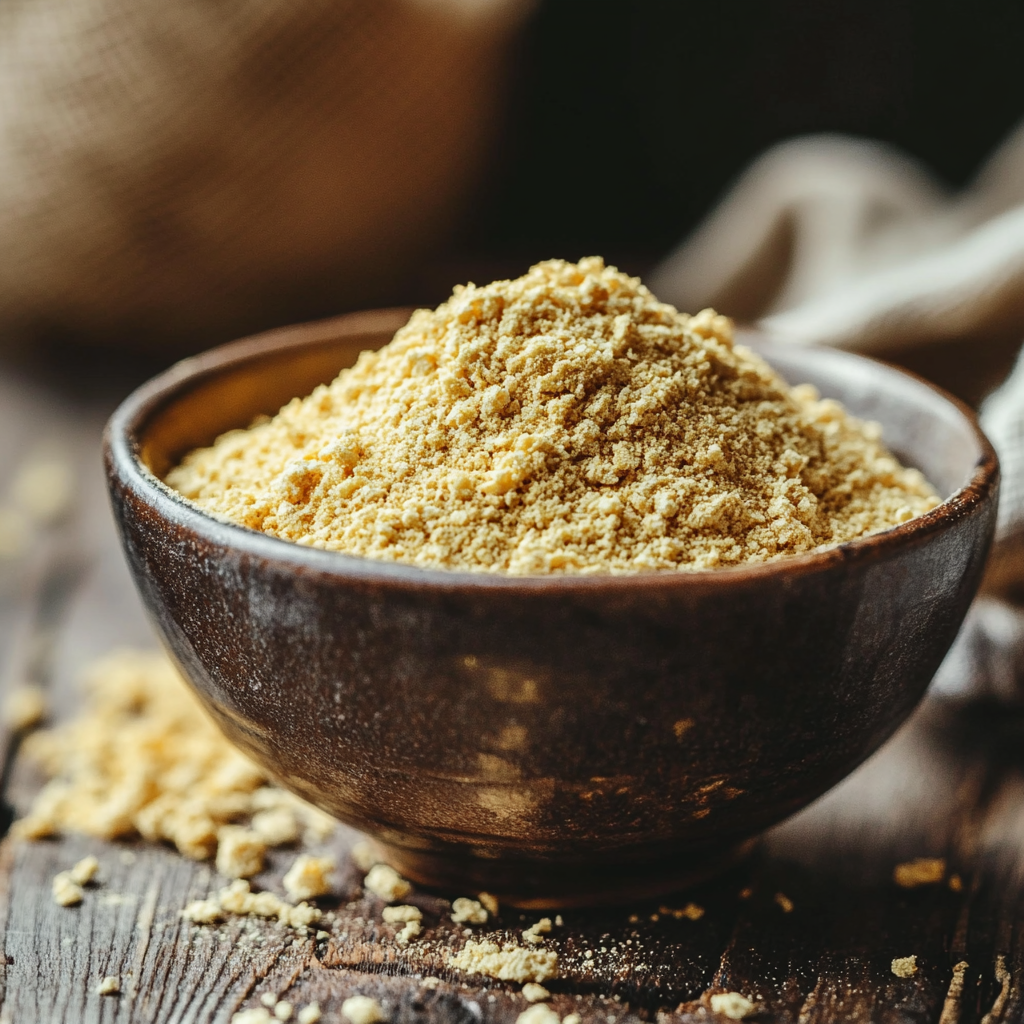What is Nutritional Yeast? How it's Made. Benefits, Uses, & More!
If you've been vegan for any decent amount of time, like me, you've probably consumed nutritional yeast whether you've known it or not.
This magical dust is so well known and beloved that it even has a nickname - nooch. It can be used to jazz up a myriad dishes, but is most often than not found in vegan restaurants and kitchens.
But what exactly is nutritional yeast? How is the stuff made? Is it healthy, and what can you do with it? Let's find out.
What is Nutritional Yeast?

Nutritional yeast is a yellow, flaky or granular, seasoning used to add umami to any savory dish. It can be sprinkled on top of finished dishes, like popcorn, or added to dishes like sauces or soups during the cooking process.
Nutritional yeast is made from an inactive version of Saccharomyces cerevisiae; the same kind of yeast used to make breads and beer.
This seasoning naturally contains no animal products, so it's always vegan. It's often referred to as having a "cheesy" flavor, but can be added to anything to give a bit of extra umami.
How Nutritional Yeast is Made
I've been familiar with nutritional yeast for over 10 years now, but how it was made was always a mystery.
First, yeast cultures are fermented in vats and fed molasses from sugar beets or cane. The yeast cells then grow for several days. Then, the active yeast is put into a centrifuge and separated.
During this process yeast cream, a milky product, is created. The yeast cream is then heated and pasteurized. The pasteurization process deactivates the yeast, thus killing active cells and stopping its ability to grow. Thus, rendering an inactive yeast.
Next the yeast can be fortified with various minerals and vitamins. Finally, the nutritional yeast is dried and rolled into flakes or crushed into a powder and ready for packaging and distribution.
The Health Benefits of Nutritional Yeast
In addition to using nutritional yeast as a taste booster to savory foods, another reason to use it are its health benefits. It's a rich source of protein, fiber, and B-complex vitamins, but nutritional yeast can also contain other vitamins and minerals if it's been fortified.
Because the nutritional benefits can vary greatly between different producers, it is necessary to read the packaging for exact nutritional information.
On average though, data shows that two teaspoons provides 20 calories with two grams of carbohydrates. It also contains three grams of protein in a serving, with all nine essential amino acids the body needs but doesn't produce on its own.
Unfortified nutritional yeast provides between 35 to 100 percent of the recommended daily value of vitamins B1 and B2.
Nutritional yeast on its own does not contain B12, but it's often added. Just two teaspoons (five grams) of fortified nutritional yeast contains:
- 20 calories
- 3 grams of protein
- 0 grams of fat
- 2 grams of carbs
- 0 grams of sugar
- 4% of the Daily Value (DV) of fiber
- 246% of the DV of Riboflavin (vitamin B2)
- 109% of the DV of Niacin (vitamin B3)
- 212% of the DV of Vitamin B6
- 59% of the DV of Folate (vitamin B9)
- 313% of the DV of Vitamin B12
- 2% of the DV Iron
- 2% of the DV of Potassium
Fortified nutritional yeast typically also contains B3 (niacin) and B6. Trace minerals, like zinc, selenium, manganese and molybdenum are also found in nutritional yeast.
Nutritional yeast also contains the powerful antioxidants glutathione and selenomethionine. These antioxidants can potentially aid in fighting free radicals that destroy cells, and can also help your body destroy toxins related to the environment and play a role in the fight against heart disease and cancer.
As with oats and barley, some studies have shown that nutritional yeast can aid in lowering cholesterol due to the beta-glucan found in it, and it may also boost the immune system and protect against chronic diseases.
Unlike cheese, which contains saturated fat, nutritional yeast is fat-free, another heart-healthy attribute. Nutritional yeast is also low in calories and sodium, sugar-free, and gluten-free. Plus, if it's fortified with B12, especially important to vegans, it can contribute to a healthy nervous system.
Buying and Storing Nutritional Yeast
As nutritional yeast becomes more and more popular, it has also become easier and easier to find. Once only something you could get at specialty shops like health food stores, and vegan or vegetarian shops, now you can find it in almost any larger super market or online retailer.
As mentioned previously, nutritional yeast comes in a flaky and granular version. BRAGG's nutritional yeast is the gold standard, but Bob's Red Mill, Now Nutritional Yeast Flakes, and Anthony's Premium Nutritional Yeast Flakes are all solid options.
That said, there are a plethora of brands out there, and even Wal-Mart has its own. So, it may take a bit of trial and error to find the one that you prefer the most. However, I personally have found that the flaky nooch is far superior in quality and flavor than the granular version.
Once home, store nutritional yeast in a cool, dark place or the refrigerator in a tightly sealed bag or jar. When stored properly, nutritional yeast should last about two years.
Using Nutritional Yeast

Whether used while cooking, or as an accoutrement sprinkled atop food, nutritional yeast is a versatile addition to any kitchen. Some of the more popular ways to use nutritional yeast are as follows.
- Sprinkle on popcorn. This gives popcorn a deeper, cheesy flavor. Some tasty combos are nooch and smoked paprika, nooch and butter, and garlic, butter and nutritional yeast. Some movie theaters even have it at the counter.
- Mix into soups and stews to give it depth and umami.
- Add to pasta pasta sauces like bolognese, in mashed potatoes, taco "meat", or in tofu scrambles to give it a tasty, cheesy flavor. You can even sprinkle it on top once the dish is plated to give it an extra boost.
- Toss with potatoes or veggies like beets, cauliflower, and others before roasting.
- In pesto instead of parmesan cheese.
- In this vegan parmesan cheese recipe to use any way you would the original.
- In dips to thicken and give them an extra zing.
- In French toast batter to balance the sweetness and add umami.
As you can see, nutritional yeast can be used in a variety of ways, and also adds a dash of healthy benefits to any meal.
What is Nutritional Yeast? - Final Thoughts
In particular, for vegans, nutritional yeast has become a staple.
Whether a person is a pro in the kitchen and advanced at whipping up delicious meals, or a newbie vegan and still learning the ropes, nutritional yeast can play a key role in anyone's life in an ever evolving culinary world.
